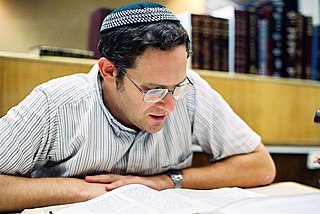Halakha, also transliterated as halacha, halakhah, and halocho, is the collective body of Jewish religious laws that are derived from the Written and Oral Torah. Halakha is based on biblical commandments (mitzvot), subsequent Talmudic and rabbinic laws, and the customs and traditions which were compiled in the many books such as the Shulchan Aruch. Halakha is often translated as "Jewish law", although a more literal translation might be "the way to behave" or "the way of walking". The word is derived from the root which means "to behave". Halakha not only guides religious practices and beliefs; it also guides numerous aspects of day-to-day life.

Judaism is an Abrahamic monotheistic ethnic religion that comprises the collective spiritual, cultural, and legal traditions of the Jewish people. Along with Samaritanism, to which it is closely related, Judaism is one of the two oldest Abrahamic religions.

In Judaism, the Seven Laws of Noah, otherwise referred to as the Noahide Laws or the Noachian Laws, are a set of universal moral laws which, according to the Talmud, were given by God as a covenant with Noah and with the "sons of Noah"—that is, all of humanity.

Orthodox Judaism is the collective term for the traditionalist branches of contemporary Judaism. Theologically, it is chiefly defined by regarding the Torah, both Written and Oral, as revealed by God to Moses on Mount Sinai and faithfully transmitted ever since.
A rabbi is a spiritual leader or religious teacher in Judaism. One becomes a rabbi by being ordained by another rabbi—known as semikha—following a course of study of Jewish history and texts such as the Talmud. The basic form of the rabbi developed in the Pharisaic and Talmudic eras, when learned teachers assembled to codify Judaism's written and oral laws. The title "rabbi" was first used in the first century CE. In more recent centuries, the duties of a rabbi became increasingly influenced by the duties of the Protestant Christian minister, hence the title "pulpit rabbis", and in 19th-century Germany and the United States rabbinic activities including sermons, pastoral counseling, and representing the community to the outside, all increased in importance.

Judaism does not centralize authority in any single individual or group. The formulation of principles of faith that are universally recognized by all branches of Judaism remains undefined. There is no central authority in Judaism in existence today - although the Sanhedrin, the supreme Jewish religious court, would fulfill this role if it were re-established. Instead, Judaism's principles of faith remain debated by the rabbis based on their understanding of the sacred writings, laws, and traditions, which collectively shape its theological and ethical framework. The most accepted version in extent is the opinion of Maimonides.
Torah Judaism refers to schools of thought in Judaism perceived to be most adherent to the Torah and mitzvot. The term is often used by Orthodox Jewish groups to refer to their own system of beliefs.

A yeshiva is a traditional Jewish educational institution focused on the study of Rabbinic literature, primarily the Talmud and halacha, while Torah and Jewish philosophy are studied in parallel. The studying is usually done through daily shiurim as well as in study pairs called chavrusas. Chavrusa-style learning is one of the unique features of the yeshiva.

Modern Orthodox Judaism is a movement within Orthodox Judaism that attempts to synthesize Jewish values and the observance of Jewish law with the modern world.
Semikhah is the traditional Jewish name for rabbinic ordination.

Ger toshav is a halakhic term used in Judaism to designate the legal status of a Gentile (non-Jew) living in the Land of Israel who does not want to convert to Judaism but agrees to observe the Seven Laws of Noah, a set of imperatives which, according to the Talmud, were given by God as a binding set of universal moral laws for the "sons of Noah"—that is, all of humanity. A ger toshav, especially one who decides to follow the Noahic covenant out of religious belief rather than ethical reasoning, is commonly deemed a "Righteous Gentile", and is assured of a place in the World to Come .
According to Rabbinic Judaism, the Oral Torah or Oral Law are statutes and legal interpretations that were not recorded in the Five Books of Moses, the Written Torah, and which are regarded by Orthodox Jews as prescriptive and given at the same time. This holistic Jewish code of conduct encompasses a wide swathe of rituals, worship practices, God–man and interpersonal relationships, from dietary laws to Sabbath and festival observance to marital relations, agricultural practices, and civil claims and damages.

Rabbinic Judaism, also called Rabbinism, Rabbinicism, or Rabbanite Judaism, has been an orthodox form of Judaism since the 6th century CE, after the codification of the Babylonian Talmud. Rabbinic Judaism has its roots in the Pharisaic school of Second Temple Judaism, and is based on the belief that Moses at Mount Sinai received both the Written Torah and the Oral Torah from God. The Oral Torah, transmitted orally, explains the Written Torah. At first, it was forbidden to write down the Oral Torah, but after the destruction of the Second Temple, it was decided to write it down in the form of the Talmud and other rabbinic texts for the sake of preservation.
Jewish leadership has evolved over time. Since the destruction of the Second Temple in Jerusalem in 70 CE, there has been no single body that has a leadership position over the entire Jewish diaspora. Various branches of Judaism, as well as Jewish religious or secular communities and political movements around the world elect or appoint their governing bodies, often subdivided by country or region.
Schisms among the Jews are cultural as well as religious. They have happened as a product of historical accident, geography, and theology.
Although rare, there are instances within Jewish law that mandate a Jew to sacrifice their own life rather than violate a religious prohibition. One of these prohibitions is that no life should be taken, including one's own. Many more ritual prohibitions exist as well, which means that under limited circumstances a Jew has to self-sacrifice when the greater good calls for breaking a more minor dictate. This practice reflects the practical and perhaps malleable nature of Judaic law.
Kevod HaBeriyot (Hebrew: כבוד הבריות; literally in Hebrew: "honor [of/due to] the [God's] creations " also variously translated as "individual dignity", "individual honor", or "human dignity" is a concept of Halakha originating in the Talmud which permits exceptions to Rabbinic decrees under certain circumstances. This concept has been used in a number of contemporary Jewish religious-law decisions in Orthodox and Conservative Judaism.
Yeridat ha-dorot, meaning literally "the decline of the generations", or nitkatnu ha-dorot, meaning "the diminution of the generations", is a concept in classical Rabbinic Judaism and contemporary Orthodox Judaism expressing a belief in the intellectual inferiority of subsequent, and contemporary Torah scholarship and spirituality in comparison to that of the past. It is held to apply to the transmission of the "Revealed" aspects of Torah study, embodied in the legal and homiletic Talmud, and other mainstream rabbinic literature scholarship. Its reasoning derives from the weaker claim to authoritative traditional interpretation of scripture, in later stages of a lengthening historical chain of transmission from the original revelation of the Torah at Mount Sinai, and the codification of the Oral Torah in the Talmud. This idea provides the basis to the designated Rabbinic Eras from the Tannaim and Amoraim of the Talmud, to the subsequent Gaonim, Rishonim and Acharonim. Additionally, it has an extra metaphysical explanation in Kabbalah, regarding lower levels of souls in succeeding generations.
Hashkafa is the Hebrew term for worldview and guiding philosophy, used almost exclusively within Orthodox Judaism. A hashkafa is a perspective that Orthodox Jews adopt that defines many aspects of their lives. Hashkafa thus plays a crucial role in how these interact with the world around them, and influences individual beliefs about secularity, gender roles, and modernity. In that it guides many practical decisions—where to send children to school, what synagogue to attend, and what community to live in—hashkafa works in conjunction with halakha or Jewish law.
Beginning in October 2004, an attempt was made to re-establish a revived Sanhedrin, a national rabbinical court of Jewish law in Israel. The organization heading this attempt referred to itself as the nascent Sanhedrin or developing Sanhedrin, and regarded itself as a provisional body awaiting integration into the Israeli government as both a supreme court and an upper house of the Knesset. The Israeli secular press regards it as an illegitimate fundamentalist organization of rabbis. The organization, which was composed of over 70 rabbis, claimed to enjoy recognition and support from the entire religious Jewish community in Israel. However, it was mostly ignored by the Haredi community, and stirred debate in both religious and secularist circles. There has not been a "full meeting" of the Sanhedrin since 2005 and its leader resigned in 2008. Haredi Zionist rabbis involved in the Sanhedrin revival attempt included Yisrael Ariel and Yoel Schwartz.






